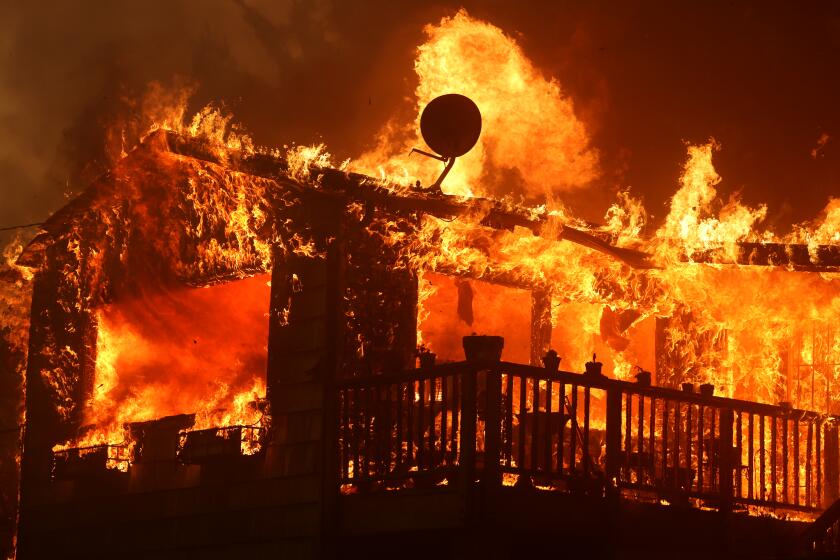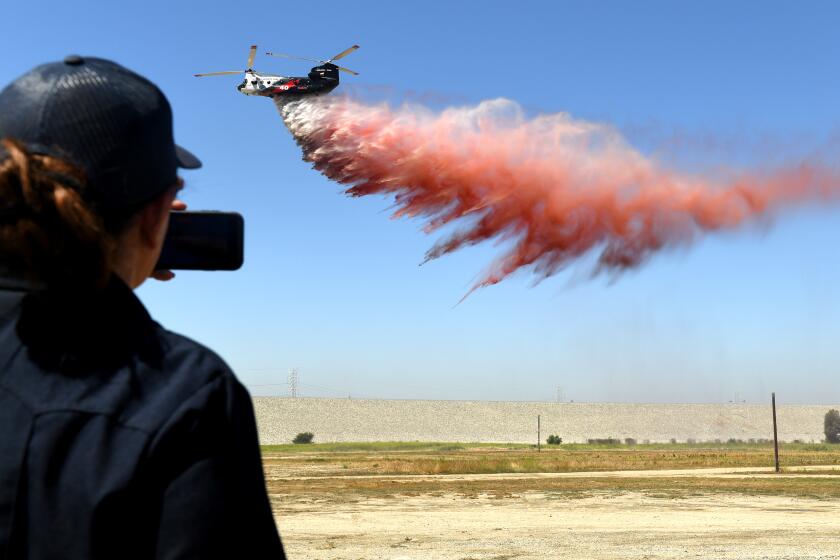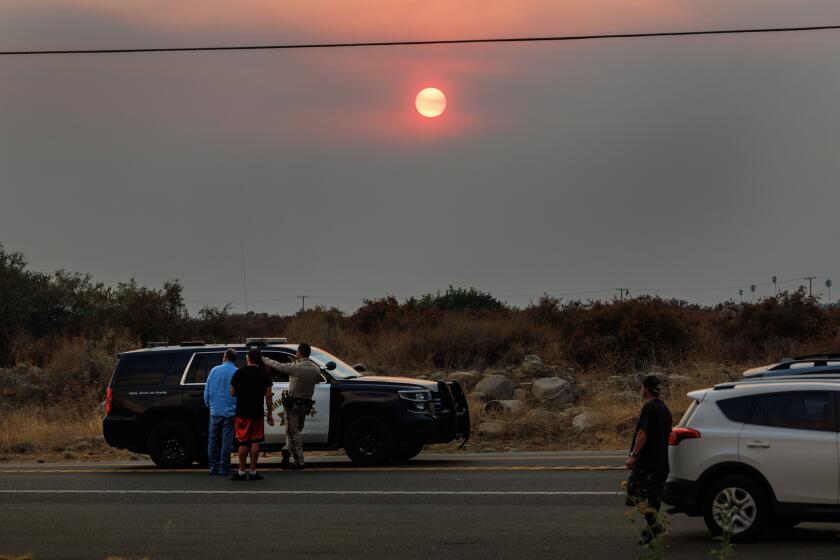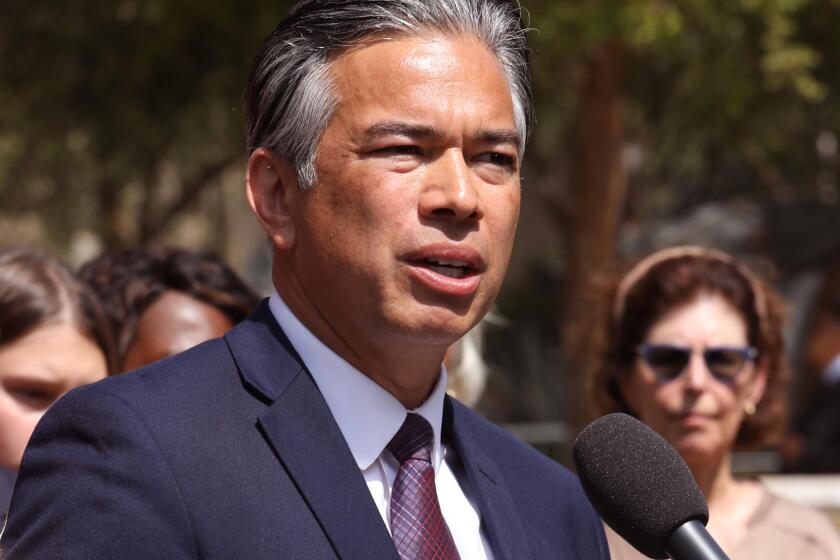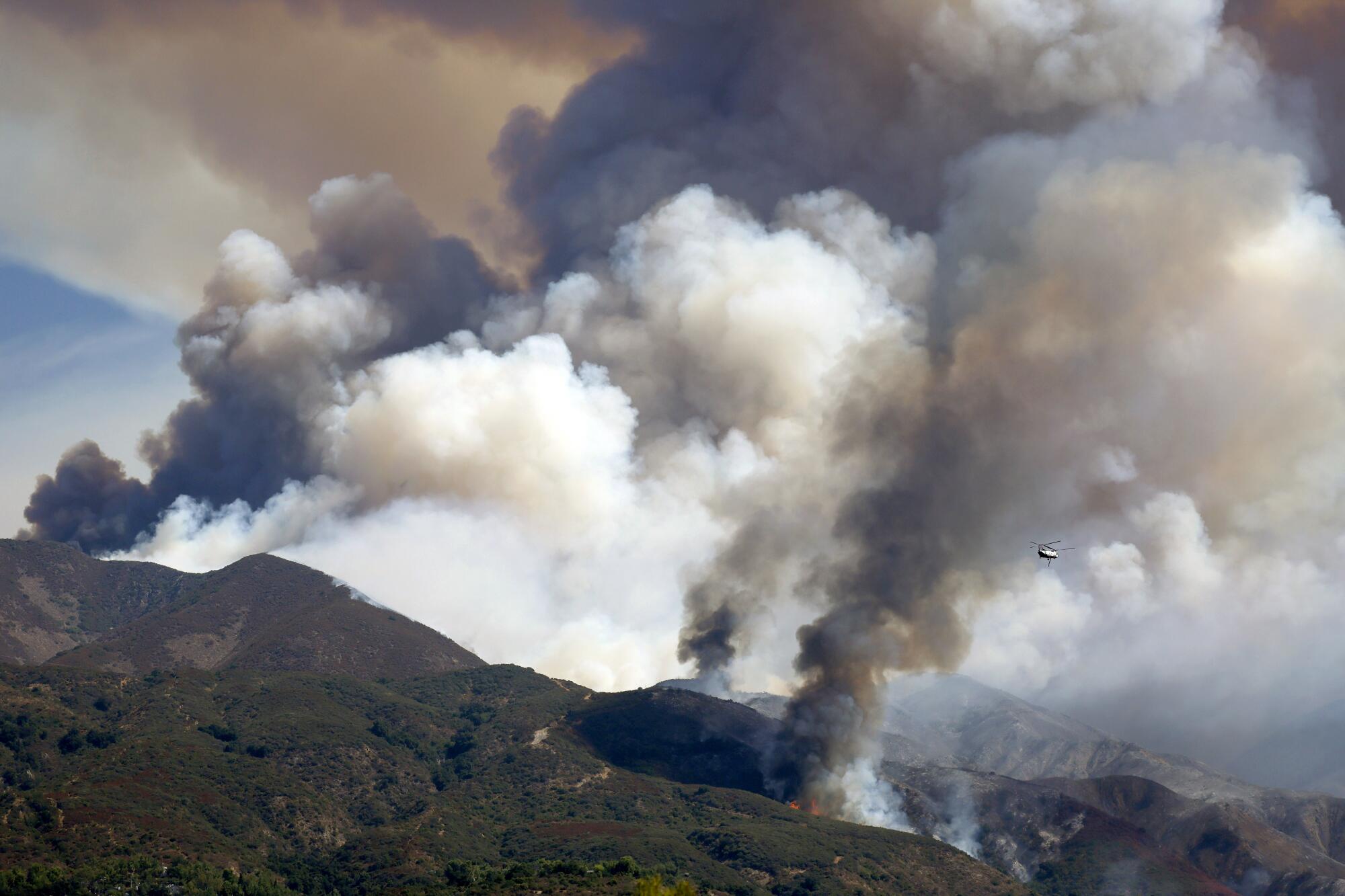
- Share via
For the first time in years, Southern California has found itself once again besieged by wildfire. In recent days, multiple blazes have exploded across heat-seared hillsides, blanketing the region in ash and smoke, threatening homes and communication towers and sending thousands of residents fleeing for their lives.
But as crews struggle to contain the 37,000-acre Line fire in San Bernardino County, the 23,000-acre Airport fire in Orange and Riverside counties, and the 51,000-acre Bridge fire in Los Angeles and San Bernardino counties, experts warn the season is just getting started.
The impending arrival of hot Santa Ana winds — combined with two years of overgrown vegetation — all but ensure that this fall will be fraught with danger.
“The odds definitely favor a continuation — and maybe even an escalation — of Southern California fire season over the next couple of months,” said Daniel Swain, a climate scientist with UCLA.
After a heat wave struck Southern California, fires erupt across the Southland, burning hundreds of thousands of acres while threatening homes.
The setup for the worst wildfire conditions in Southern California is an especially wet rainy season followed by an extremely hot and dry period — exactly what’s happening now after back-to-back rainy winters, an arid summer and a record-shattering heat wave, Swain said.
Aggressive and impactful reporting on climate change, the environment, health and science.
What’s more, there is some indication that fire-fanning Santa Ana winds could arrive as soon as mid-September — well before California’s traditional rainy season. The winds will meet with not only dried vegetation, but vegetation that hasn’t burned in years, making it all the more primed for combustion, Swain said.
“We’re going to have this condition of unusually abundant grass and brush — plus the legacy of this recent record heat — until it rains, and the problem is most of Santa Ana wind season is likely to occur in Southern California before it does so,” Swain said. “That’s the big concern. That’s why this fall, there does appear to be an increased likelihood of above-average fire conditions throughout much of Southern California.”
Three wildfires raged in Southern California on Tuesday night. The Bridge fire exploded to eight times its size as it raced toward the Mountain High Ski Resort and Wrightwood.
The region has seen bad fire seasons before, including in 2003 and 2007 — fire-filled years that wrought considerable death and destruction.
The region also saw devastation in 2017, when the Thomas fire tore through 282,000 acres in Ventura and Santa Barbara counties; in 2018, when the Woolsey fire destroyed more than 1,600 structures in Malibu and surrounding areas; and 2020, when the Bobcat fire nearly burned down the Mt. Wilson Observatory in the Angeles National Forest.
All three of those fires started later in the year — between September and December — which is in keeping with traditional patterns in the region, according to Robert Foxworthy, a spokesperson with the California Department of Forestry and Fire Protection.
“Normally what’s the most damaging and destructive time of the year for Southern California is a little further into the season — that’s when we usually see those Santa Anas starting,” he said. “We’re a little ahead of schedule with seeing a lot of that activity. What the fires we’re seeing now are showing us is that those fuels are primed and ready to burn and receptive and showing very large growth.”
Track wildfire origins, perimeters and air pollution with the L.A. Times California wildfires map.
But there remains cause for optimism.
Crews are becoming ever-more adept at fighting fires and have begun rolling out new helicopters that enable them to battle blazes overnight and new technology that can catch ignitions sooner, Foxworthy said.
“As we advance, everything advances, including weather forecasting, fire prediction, all those things,” he said.
The same is true for California residents — who are much more likely to evacuate ahead of a fire now than they were in decades past — and for crews, who are becoming more accustomed to battling the kinds of blazes that formerly may have come around only once or twice in a career, Foxworthy said.

“Californians are very savvy to fire because they’re very experienced with fire, so the more that the public and firefighters experience those conditions, honestly, the better that they are at tackling those conditions as we move forward,” he said.
Planned power shutoffs from utility companies have also helped reduce the overall number of fires started by their equipment in recent years, according to data from the California Public Utilities Commission.
But the Airport fire was unintentionally started by public works crews using heavy equipment in the area while trying to reduce the fire risk, underscoring how flammable the vegetation is.
Southern California conflagrations can pose a particular risk because of their proximity to dense population centers. In such instances, the potential for wind-driven fires is even more worrisome “because they can occur with the least amount of warning and move into populated areas even faster than the fires we’re seeing right now,” Swain said.
He said Southern California is so primed to burn that the odds of seeing an unusually high number of large and destructive fires this autumn are greater than usual — even accounting for the “trend toward more extreme autumn fire conditions in California in a warming climate.”
The Quick Reaction Force from the Los Angeles, Ventura and Orange county fire departments will be available 24 hours a day all year long.
The warnings dovetail with the latest seasonal outlook issued by the National Interagency Fire Center, or NIFC, which forecast increased wildfire activity in Southern California in September due to the combination of weather and vegetation.
There is also a tilt in the odds toward above-normal fire potential across most of Southern California in October and November — and even into December along the South Coast due to “an increasingly likely dry fall and a delayed start to the wet season,” the outlook says.
Piper Brandt, a public affairs specialist with NIFC, said fuel loads — or the amount of grasses and other flammable vegetation — are in some places as high as 198% of normal, even in deserts and dry valleys that often don’t have sufficient vegetation for wildfires.
“This, combined with above normal temperatures and below average precipitation expected to continue into October, means that California can expect to see increased fire potential,” Brandt said.
Climate models also suggest that La Niña will develop and bring a warmer and drier pattern to the central and southern part of the state during the fall and winter months, according to the NIFC outlook. The agency has issued a fuel and fire behavior advisory for Southern California that warns of “a highly flammable fire environment where rapid fire growth has been observed and is expected to continue for initial attack fires.”
Indeed, the Line, Airport and Bridge fires have already exhibited dangerous behavior, including rapid growth that prompted mandatory evacuation orders across the region. The fires are spewing dense canopies of smoke, and the Line and Airport fires have both caused injuries, officials said.
The NIFC has also set the current national preparedness level to 5 — the highest possible — indicating that federal resources are fully committed and the potential for significant wildland fires to emerge is expected to remain high across multiple geographic areas.
“There’s increased fire activity, there’s more fires, and resources are spread thin just based on the needs of all those fires,” Brandt said, noting that there are active blazes across the West including Idaho, Oregon, Washington and Nevada.
There are indications that some Western wildfire activity will die down with changing weather soon, she said, “but for now we’re doing our best to prioritize resources and send them where they’re needed most.”
The South Coast Air Quality Management District issues an air quality alert due to elevated fine particle pollution levels due to wildfire smoke and ozone pollution.
But as with any weather or climate-related prediction, there are no guarantees.
It’s too soon to say how strong or how frequent Santa Ana winds will be this year, or whether Southern California will see a lucky burst of fire season-ending rain, as it did with Tropical Storm Hilary last year.
What is clearer, however, is that vegetation is abundant and dry, and that fall in Southern California is likely to see continued dryness and warmth, according to the latest seasonal outlooks from the National Oceanic and Atmospheric Administration.
“We could get lucky with the pieces that are not so predictable,” Swain said. “But right now the predictable pieces align in a way that strongly points toward a very active, above-average, potentially problematic fire season this autumn.”
Toward a more sustainable California
Get Boiling Point, our newsletter exploring climate change, energy and the environment, and become part of the conversation — and the solution.
You may occasionally receive promotional content from the Los Angeles Times.
